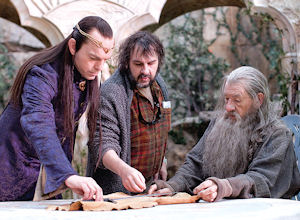When crowds flock to Park City, Utah for the Sundance Film Festival later this month, among the attendees will be a group of 20 people from the San Fernando Valley. They will be attending the leading festival of independent film on a trip organized by the Valley Industry & Commerce Association. So why is a business advocacy group better known for its annual forecast and mixers with local business leaders and elected officials attending Sundance? “We have a lot of entertainment industry partners,” is the simple explanation of President Stuart Waldman. “All around it is a unique experience that the average person gets to experience.” VICA first organized a trip to last year’s festival that included representatives of the major Hollywood studios in the Valley. This year’s trip to the festival, held Jan. 17-27, is already sold out. Among those attending through VICA is Paul Audley, the president of Film L.A. Inc., a nonprofit that handles film permitting in much of Los Angeles County. Anyone can attend the festival on their own, but it’s hard to get a hotel room or tickets to movies. VICA has created a package that includes airfare, lodging and access to certain movies and panel discussions. The cost is $1,699 – not including the schmoozing. Indeed, Waldman expects that many attendees, aside from simply taking in what he called a once-in-a-lifetime experience, will try to expand their industry contacts. “I know a lot of people who end up taking a meeting when they are there. It’s an opportunity to connect with somebody,” he said. What’s also interesting, he said, is that the festival is not only attended by famous actors, directors and producers, but many so-called below-the-line crew members who live and work in the Valley – grips, gaffers, production assistants and the like. At premieres of the films when a director is asked to say a few words they will ask the crew members in attendance to be recognized. “Fifty people will stand up,” Waldman said. This year’s festival received more than 12,000 feature length and short film submissions from which more than 100 features by filmmakers from 32 countries were selected for screenings. “There are some films you wouldn’t wish your worst enemy even to see,” Waldman said. “Then there are some so incredible you talk about years afterward.” Jarring Experience After two weeks in theaters, “The Hobbit: An Unexpected Journey” brought in $523 million at the global box office. That amount includes the $10 I paid to see the film at the AMC Theatres at Universal City Walk a few days before Christmas. For my first viewing of “The Hobbit” I chose the version shown in 48 frames per second, a new higher-resolution movie format that is being debuted with the latest film version of J.R.R. Tolkien’s classic book. But when I left the theater I was not a fan of the format. There was something about the picture that never looked right. There is a noticeable difference between the standard format in which movies are filmed and projected at 24 frames per second and the 48-frame format that captures twice as much visual imagery. In fact, I am looking forward to seeing “The Hobbit” a second time in the standard format just to compare the two. What I could not shake while sitting in the darkened theater for nearly three hours was how much the picture looked like what you would see on television. In close-up scenes shot during daylight in particular, the look was distracting because the background looked so artificial and static. Yet, the faster frame rate might one day be the future of all film. There are two more “Hobbit” films that director Peter Jackson shot at that speed. And James Cameron is upping the ante on his “Avatar” sequel that he wants to film at 60 frames per second. Will there be long-term implications for Hollywood from Jackson having gone with the faster frame rate? Will “The Hobbit” be this year’s “Avatar” by showing the extent of what technology can do at the movies? “This has an opportunity to grab people the same way, although it is not playing in the same number of theaters in (high frame rate) as ‘Avatar’ was in 3-D,” said Marty Shindler, an Encino management consultant who has expertise in the nexus of entertainment and technology. Warner Bros., the distributor of the “The Hobbit,” purposely limited the 48-frame version to no more than 450 theaters. This was so the introduction of this new technology to both the theater operators and the public was done right, Warner Bros. Domestic Distribution President Dan Fellman told Deadline Hollywood back in November. Shindler believes that high frame-rate films are still years away from widespread acceptance. But it won’t be for the eyes of people of Shindler’s or even my generation that this format will continue to be developed and improved. It will be for teens and young adults who watch much of their content in high definition on their phones or tablets, and when they watch television it is on ever-larger screens, Shindler said. “Those (movie) screens can be retrofitted to an LCD presentation, and it is what the younger generation is used to,” he said. Staff Reporter Mark R. Madler can be reached at (818) 316-3126 or by e-mail at [email protected].
